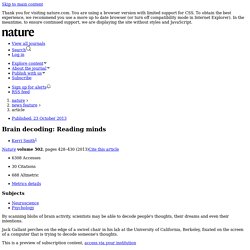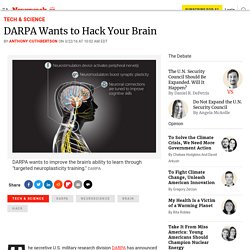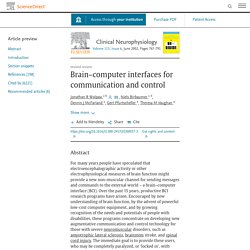

Brain Implants for Mood Disorders Tested in People. Screen-based media associated with structural differences in brains of young children. A new study documents structural differences in the brains of preschool-age children related to screen-based media use.

The study, published in JAMA Pediatrics, shows that children who have more screen time have lower structural integrity of white matter tracts in parts of the brain that support language and other emergent literacy skills. These skills include imagery and executive function -- the process involving mental control and self-regulation. These children also have lower scores on language and literacy measures. The Cincinnati Children's Hospital Medical Center study assessed screen time in terms of American Academy of Pediatrics (AAP) recommendations. The AAP recommendations not only take into account time spent in front of screens but also access to screens, including portable devices; content; and who children are with and how they interact when they are looking at screens.
Among the AAP recommendations: Dr. Paralysed man moves in mind-reading exoskeleton. Brain decoding: Reading minds. Jack Gallant perches on the edge of a swivel chair in his lab at the University of California, Berkeley, fixated on the screen of a computer that is trying to decode someone's thoughts.

On the left-hand side of the screen is a reel of film clips that Gallant showed to a study participant during a brain scan. And on the right side of the screen, the computer program uses only the details of that scan to guess what the participant was watching at the time. Anne Hathaway's face appears in a clip from the film Bride Wars, engaged in heated conversation with Kate Hudson. The algorithm confidently labels them with the words 'woman' and 'talk', in large type. Another clip appears — an underwater scene from a wildlife documentary. “This is a manatee, but it doesn't know what that is,” says Gallant, talking about the program as one might a recalcitrant student. Listen Neuroscientists can predict what a person is seeing or dreaming by looking at their brain activity. Beyond blobology Real world.
DARPA Wants to Hack Your Brain. The secretive U.S. military research division DARPA has announced plans to create a device that could accelerate learning in the human brain.

The targeted neuroplasticity training (TNT) program uses a method that claims to be able to improve cognitive skills by stimulating peripheral nerves. “Recent research has shown that stimulation of certain peripheral nerves, easily and painlessly achieved through the skin, can activate regions of the brain involved with learning,” said TNT program manager Doug Weber. Subscribe now - Free phone/tablet charger worth over $60 “This natural process of synaptic plasticity is pivotal for learning, but much is unknown about the physiological mechanisms that link peripheral nerve stimulation to improved plasticity and learning.”
Unlike previous programs, however, TNT aims to not just restore lost function but also advance capabilities beyond normal levels.
EPFLx: BIO465X - Neuronal Dynamics - Computational Neuroscience of Single Neurons. Computational Neuro. Brain–computer interfaces for communication and control. Accepted 2 March 2002.

For many years people have speculated that electroencephalographic activity or other electrophysiological measures of brain function might provide a new non-muscular channel for sending messages and commands to the external world – a brain–computer interface (BCI). Over the past 15 years, productive BCI research programs have arisen. Encouraged by new understanding of brain function, by the advent of powerful low-cost computer equipment, and by growing recognition of the needs and potentials of people with disabilities, these programs concentrate on developing new augmentative communication and control technology for those with severe neuromuscular disorders, such as amyotrophic lateral sclerosis, brainstem stroke, and spinal cord injury.
Bits/min. This limited capacity can be valuable for people whose severe disabilities prevent them from using conventional augmentative communication methods.
Brain Implant Improves Thinking in Monkeys. What have We Learned from “Perturbing” the Human Cortical Motor System with Transcranial Magnetic Stimulation? 1 Department of Psychology, Centre for Brain and Mind, University of Western Ontario, London, ON, Canada2 Department of Psychology, The Rotman Research Institute, University of Toronto, Toronto, ON, Canada3 Department of Psychiatry, The Rotman Research Institute, University of Toronto, Toronto, ON, Canada The purpose of this paper is twofold.

First, we will review different approaches that one can use with transcranial magnetic stimulation (TMS) to study both its effects on motor behavior and on neural connections in the human brain. Second, we will present evidence obtained in TMS-based studies showing that the dorsal premotor area (PMd), the ventral premotor area (PMv), the supplementary motor area (SMA), and the pre-supplementary motor area (pre-SMA) each have different roles to play in motor behavior.
Citation: Chouinard PA and Paus T (2010) What have we learned from “perturbing” the human cortical motor system with transcranial magnetic stimulation? Front. Paralyzed, Moving a Robot With Their Minds. Motorlab. An fMRI study of the human cortical motor... [Magn Reson Imaging. 1997.